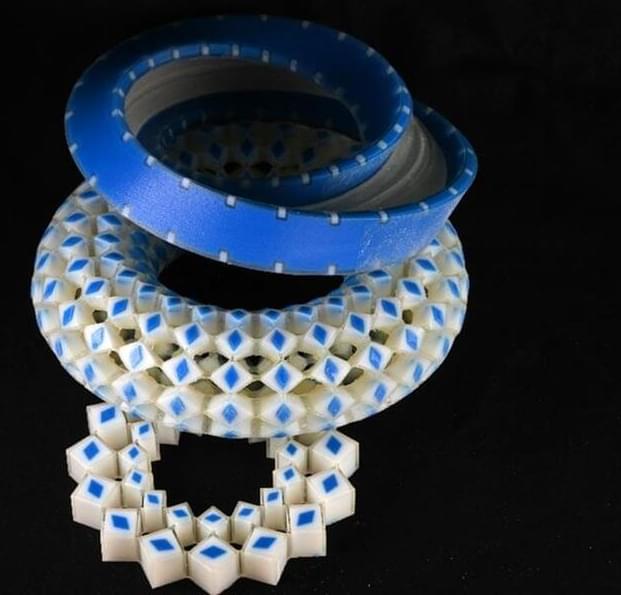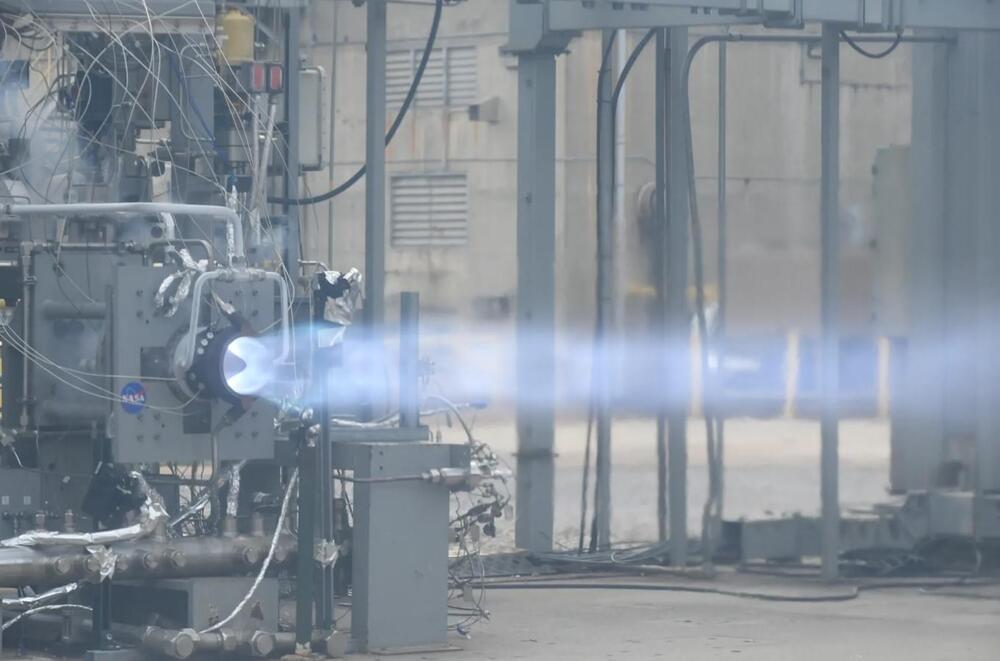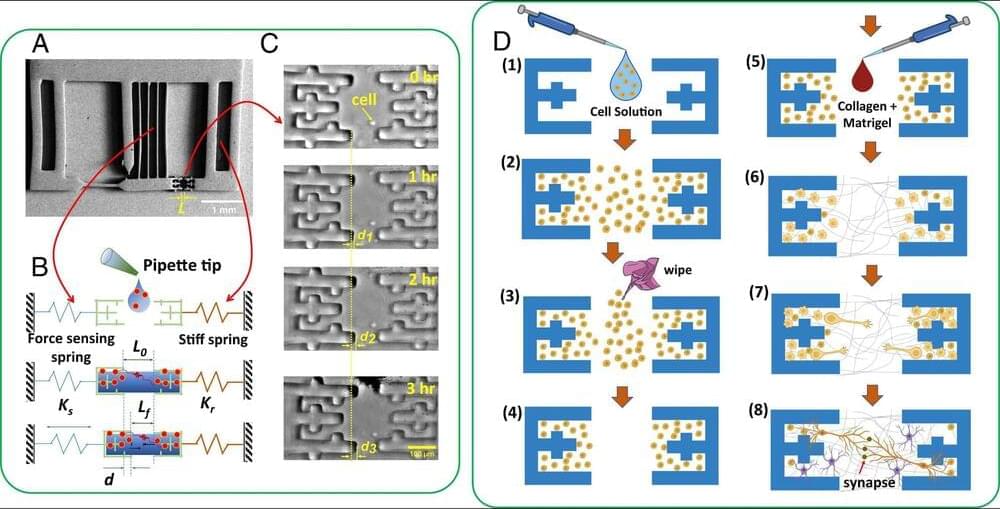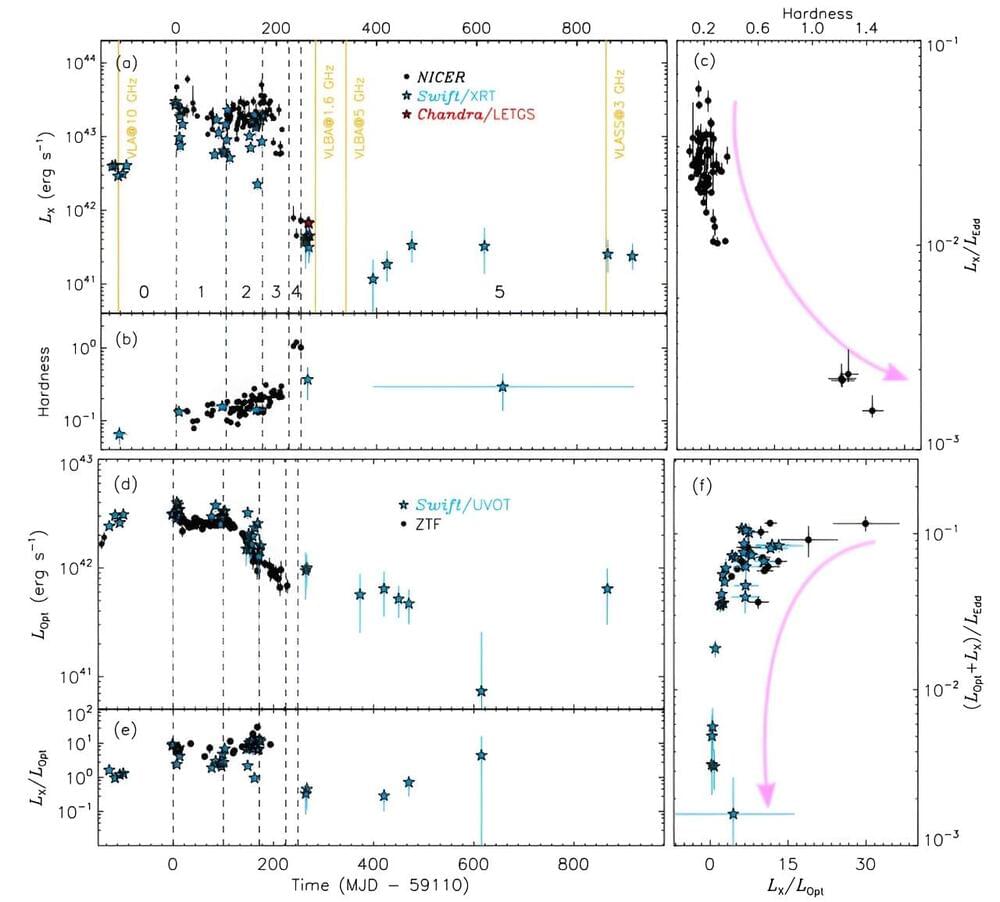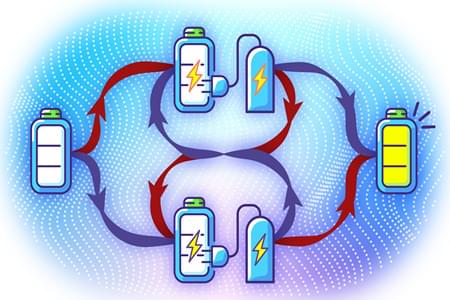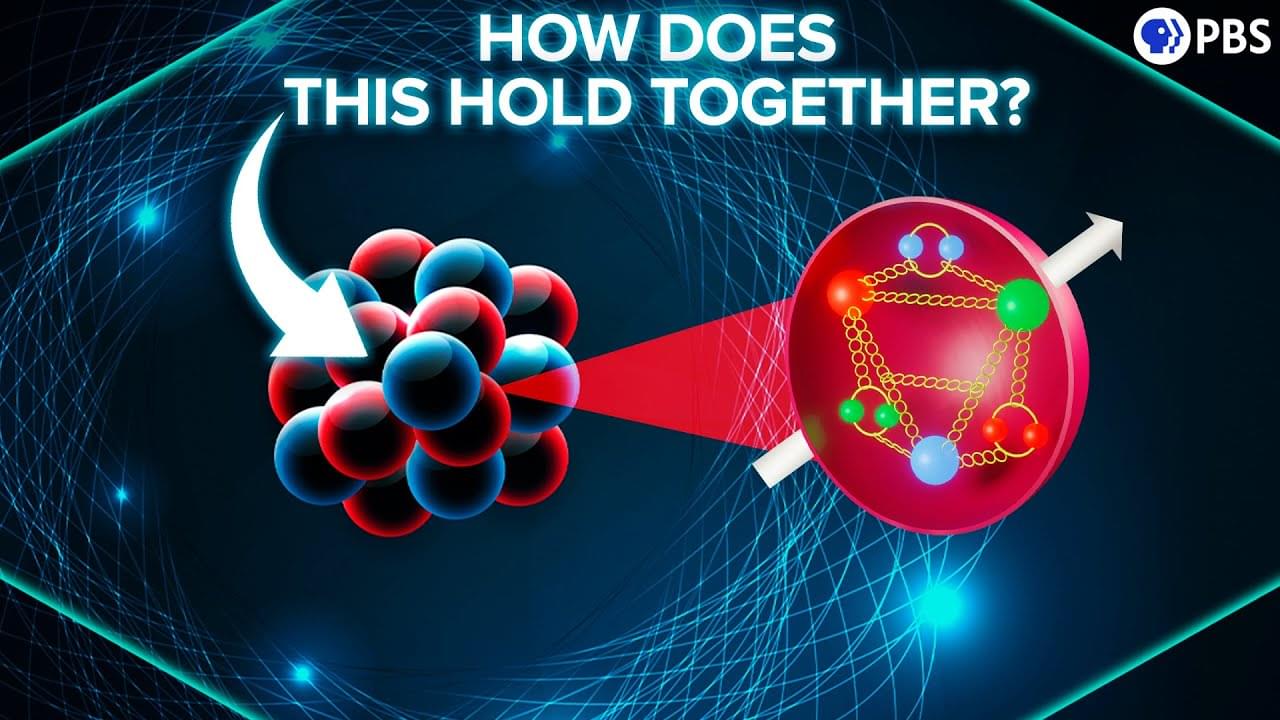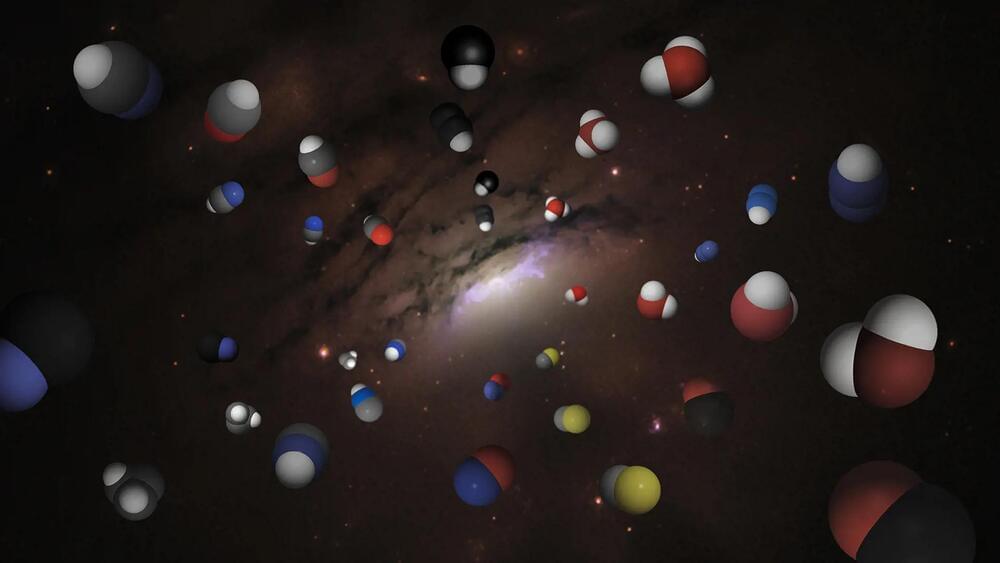Scientists studying the chemical makeup of asteroid Ryugu and the Murchison meteorite find intriguing differences in their organic molecules.
Category: chemistry – Page 129
A groundbreaking discovery in metamaterial design reveals materials with built-in deformation resistance and mechanical memory, promising advancements in robotics and computing.
Researchers from the University of Amsterdam Institute of Physics and ENS de Lyon have discovered how to design materials that necessarily have a point or line where the material doesn’t deform under stress, and that even remember how they have been poked or squeezed in the past. These results could be used in robotics and mechanical computers, while similar design principles could be used in quantum computers.
The outcome is a breakthrough in the field of metamaterials: designer materials whose responses are determined by their structure rather than their chemical composition. To construct a metamaterial with mechanical memory, physicists Xiaofei Guo, Marcelo Guzmán, David Carpentier, Denis Bartolo, and Corentin Coulais realized that its design needs to be “frustrated,” and that this frustration corresponds to a new type of order, which they call non-orientable order.
NASA has pushed forward a revolutionary new rocket technology at its Marshall Space Flight Center in Huntsville, Alabama. Engineers at the facility fired the 3D-printed Rotating Detonation Rocket Engine (RDRE) for a record 251 seconds with 5,800 lb (2,631 kg) of thrust.
For over six decades, NASA has relied on chemical rockets to launch its vehicles into space. It works, but chemical rockets suffer from the fact that they’ve been operating in the neighborhood of their theoretical limit since 1942. This isn’t helped by the fact that most liquid rockets are essentially unchanged in their basic design since the days of the German V2s.
To squeeze a bit more performance out of rocket engines, NASA is looking at a fundamentally different design with the RDRE.
Neurons in the brain communicate with each other at their synapses. It has long been understood that this communication occurs through biochemical processes. Here, we reveal that mechanical tension in neurons is essential for communication. Using in vitro rat hippocampal neurons, we find that 1) neurons become tout/tensed after forming synapses resulting in a contractile neural network, and 2) without this contractility, neurons fail to fire. To measure time evolution of network contractility in 3D (not 2D) extracellular matrix, we developed an ultrasensitive force sensor with 1 nN resolution. We employed Multi-Electrode Array and iGluSnFR, a glutamate sensor, to quantify neuronal firing at the network and at the single synapse scale, respectively. When neuron contractility is relaxed, both techniques show significantly reduced firing. Firing resumes when contractility is restored.
An international team of astronomers has employed a set of space telescopes to observe a peculiar nuclear transient known as AT 2019avd. Results of the observational campaign, presented in a paper published December 21 on the pre-print server arXiv, deliver important insights into the properties and behavior of this transient.
Nuclear astrophysics is key to understanding supernova explosions, and in particular the synthesis of the chemical elements that evolved after the Big Bang. Therefore, detecting and investigating nuclear transient events could be essential in order to advance our knowledge in this field.
At a redshift of 0.028, AT 2019avd is a peculiar nuclear transient discovered by the Zwicky Transient Facility (ZTF) in 2009. The transient has been detected in various wavelengths, from radio to soft X-rays, and has recently exhibited two continuous flaring episodes with different profiles, spanning over two years.
Charging quantum batteries in indefinite causal order. In the classical world, if you tried to charge a battery using two chargers, you would have to do so in sequence, limiting the available options to just two possible orders. However, leveraging the novel quantum effect called ICO opens the possibility to charge quantum batteries in a distinctively unconventional way. Here, multiple chargers arranged in different orders can exist simultaneously, forming a quantum superposition. ©2023 Chen et al. CC-BY-ND
Batteries that exploit quantum phenomena to gain, distribute and store power promise to surpass the abilities and usefulness of conventional chemical batteries in certain low-power applications. For the first time, researchers including those from the University of Tokyo take advantage of an unintuitive quantum process that disregards the conventional notion of causality to improve the performance of so-called quantum batteries, bringing this future technology a little closer to reality.
When you hear the word “quantum,” the physics governing the subatomic world, developments in quantum computers tend to steal the headlines, but there are other upcoming quantum technologies worth paying attention to. One such item is the quantum battery which, though initially puzzling in name, holds unexplored potential for sustainable energy solutions and possible integration into future electric vehicles. Nevertheless, these new devices are poised to find use in various portable and low-power applications, especially when opportunities to recharge are scarce.
Check out http://rocketmoney.com/pbsspace or scan the QR code on the screen to start managing your personal finances today. Thank you to Rocket Money for sponsoring today’s video! #rocketmoney #personalfinance.
PBS Member Stations rely on viewers like you. To support your local station, go to: http://to.pbs.org/DonateSPACE
Sign Up on Patreon to get access to the Space Time Discord!
https://www.patreon.com/pbsspacetime.
Two protons next to each other in an atomic nucleus are repelling each other electromagnetically with enough force to lift a medium-sized labradoodle off the ground. Release this energy and you have, well, you have a nuclear explosion. Just as well there’s an even stronger force than the electromagnetism holding our nuclei together. But it’s not the strong force, as you might have imagined. At least not directly. Nuclei are held together by a quirk of nature, without which we would have no complex atoms, no chemistry, and certainly no labradoodles.
Episode Companion Playlist.
Check out the Space Time Merch Store.
Two galaxies in the early universe, which contain extremely productive star factories, have been studied by a team of scientists led by Chalmers University of Technology in Sweden. Using powerful telescopes to split the galaxies’ light into individual colours, the scientists were amazed to discover light from many different molecules – more than ever before at such distances. Studies like this could revolutionise our understanding of the lives of the most active galaxies when the universe was young, the researchers believe.
When the universe was young, galaxies were very different from today’s stately spirals, which are full of gently-shining suns and colourful gas clouds. New stars were being born, at rates hundreds of times faster than in today’s universe. Most of this however, was hidden behind thick layers of dust, making it a challenge for scientists to discover these star factories’ secrets – until now. By studying the most distant galaxies visible with powerful telescopes, astronomers can get glimpses of how these factories managed to create so many stars.
In a new study, published in the journal Astronomy & Astrophysics, a team of scientists led by Chalmers astronomer Chentao Yang, used the telescopes of NOEMA (NOrthern Extended Millimetre Array) in France to find out more about how these early star factories managed to create so many stars. Yang and his colleagues measured light from two luminous galaxies in the early universe – one of them classified as a quasar, and both with high rates of star formation.
Immigration to and living on Mars have often been themes in science fiction. Before these dreams can become reality, humanity faces significant challenges, such as the scarcity of vital resources like oxygen needed for long-term survival on the Red Planet. Yet, recent discoveries of water activity on Mars have sparked new hope for overcoming these obstacles.
Scientists are now exploring the possibility of decomposing water to produce oxygen through electrochemical water oxidation driven by solar power with the help of oxygen evolution reaction (OER) catalysts. The challenge is to find a way to synthesize these catalysts in situ using materials on Mars, instead of transporting them from the Earth, which is of high cost.
The world works at different levels — fundamental physics, physics, chemistry, biology, psychology, sociology — with each level having its own rules and regularities. Here’s the deep question: Ultimately, can what happens at a higher level be explained entirely in terms of what happens at a lower level? If the answer is ‘No’, if complete explanatory reduction fails, then what else could be going on?\
\
Free access to Closer to Truth’s library of 5,000 videos: http://bit.ly/376lkKN\
\
Watch more interviews on strong emergence: https://bit.ly/3vZsgq4\
\
George Francis Rayner Ellis is the Emeritus Distinguished Professor of Complex Systems in the Department of Mathematics and Applied Mathematics at the University of Cape Town in South Africa.\
\
Register for free at CTT.com for subscriber-only exclusives: http://bit.ly/2GXmFsP\
\
Closer to Truth presents the world’s greatest thinkers exploring humanity’s deepest questions. Discover fundamental issues of existence. Engage new and diverse ways of thinking. Appreciate intense debates. Share your own opinions. Seek your own answers.

